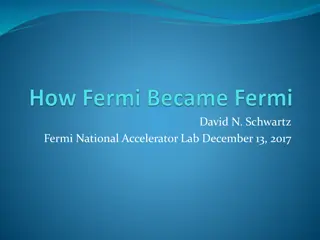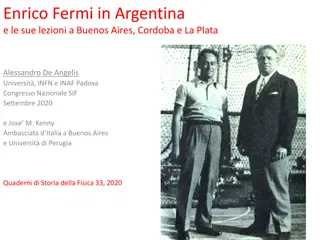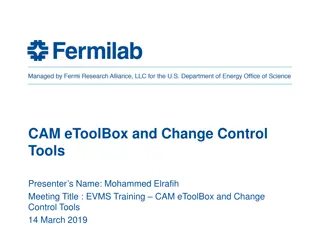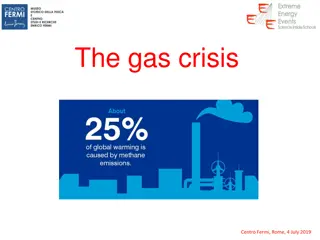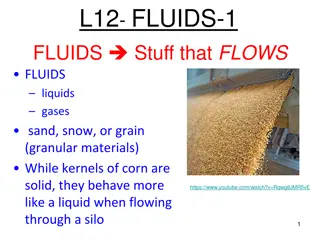States of Matter: Solids, Liquids, and Gases
Matter is anything that occupies space and has mass, consisting of tiny particles like atoms and molecules. Solids have closely packed particles, liquids have less densely packed particles that can flow, and gases have spread out particles. Solids retain their shape, liquids take the shape of their
7 views • 11 slides
Gas Laws and Properties: Understanding the Behavior of Gases
Gas laws govern the behavior of gases and their properties in various conditions. From the total pressure of gas mixtures to calculating partial pressures, understanding the relationship between pressure, volume, temperature, and amount of gas is crucial. Effusion and diffusion play key roles in how
1 views • 16 slides
The Impact of Temperature on Fermi Level in Semiconductors
The Fermi level plays a crucial role in determining the behavior of electrons in semiconductors at different temperatures. As temperature increases, the Fermi level shifts, affecting the generation of free electrons and holes in the valence and conduction bands. In intrinsic semiconductors, electron
3 views • 53 slides
The Noble Gases: Properties, Sources, and Uses
The noble gases, including helium, neon, argon, krypton, xenon, radon, and Oganesson, are characterized by their low reactivity due to a complete electron configuration. They have diverse applications, such as forming inert atmospheres, medical treatments, and lighting technologies. Naturally occurr
0 views • 16 slides
Linking Soft-Ray Pulsar and Fermi LAT Pulsar Populations
This research presentation explores the connection between the soft-ray pulsar population and the Fermi LAT pulsar population, focusing on observational data and methodologies for increasing the sample size to enhance our understanding of high-energy pulsars. The study outlines the identification pr
0 views • 13 slides
Fermi-Dirac Statistics in Solids
Electrons in solids obey Fermi-Dirac statistics, governed by the Fermi-Dirac distribution function. This function describes the probability of electron occupation in available energy states, with the Fermi level representing a crucial parameter in analyzing semiconductor behavior. At different tempe
1 views • 9 slides
Fermi Liquid Theory in Interacting Fermion Systems
Fermi liquid theory, also known as Landau-Fermi liquid theory, is a theoretical model that describes the normal state of metals at low temperatures. Introduced by Landau and further developed by Abrikosov and Khalatnikov, this theory explains the similarities and differences between interacting ferm
0 views • 23 slides
Band Population in Semiconductors
Exploring the concepts of electron and hole population in semiconductor bands through the Fermi-Dirac function, density of states, and Fermi energy. Learn how the Fermi function influences carrier concentration, the difference between metals and semiconductors in band structure, and the behavior of
0 views • 14 slides
Fermi Problems and Estimation Techniques in Science
Understand Enrico Fermi's approach to problem-solving through estimation in science as demonstrated by Fermi Problems. These problems involve making educated guesses to reach approximate answers, fostering creativity, critical thinking, and estimation skills. Explore the application of Fermi Problem
1 views • 23 slides
Fun Fermi Estimation Quiz Questions
Test your estimation skills with these quirky Fermi estimation quiz questions like guessing the number of black cabs in London or the length of toilet roll used worldwide daily. Can you make accurate guesses on topics ranging from tennis balls at Wimbledon to burgers from a cow?
1 views • 7 slides
The Fascinating Life and Work of Physicist Enrico Fermi
Enrico Fermi, a renowned physicist, made significant contributions to the field of quantum mechanics and nuclear physics. Born in Rome in 1901, he went on to receive the Nobel Prize in 1938 for his work on slow neutrons. Fermi's innovative approach as a theorist and experimenter set him apart in the
1 views • 16 slides
Insulators and Energy Bands in Materials
Explore the concept of insulators and energy bands in materials, focusing on the forbidden gap, Fermi energy levels, and the classification of solids based on electrical conductivity. Learn about the role of insulators, the energy gap in insulators, and examples of insulating materials like rubber a
0 views • 48 slides
Enrico Fermi's Lectures in South America: 1934 Overview
In 1934, Enrico Fermi embarked on a lecture tour in Argentina, Brazil, and Uruguay, delivering insightful talks on nuclear physics. Despite language barriers, his lectures attracted large audiences and covered groundbreaking topics such as beta decay theory and neutron-induced artificial radioactivi
0 views • 9 slides
Extrinsic Semiconductors: Fermi Level and Doping Effects
Extrinsic semiconductors play a crucial role in modern electronics by allowing controlled addition of impurities to tailor conductivity. The Fermi level in extrinsic semiconductors shifts based on the number of electrons and holes in the conduction and valence bands, influencing conductivity. Doping
0 views • 14 slides
Quantum Statistics and Applications in Fermi Gases
Exploring the fascinating world of quantum statistics and applications in degenerate Fermi gases, electrons in metals, neutron stars, and 3He. Dive into concepts like Fermi energy, particle behavior in boxes, counting states, and more at varying temperatures. Understand the comparison between free e
0 views • 19 slides
EEE Runs Update: Statistics and Performance Summary as of June 3, 2019
Total tracks acquired, days of data taking, candidate tracks per day, performance metrics, and duty cycle information for the EEE telescope network up to Run 5, as reported by Fabrizio Coccetti at Centro Fermi Museo Storico della Fisica e Centro Studi e Ricerche Enrico Fermi in Rome, Italy. The netw
0 views • 16 slides
EVMS Training CAM eToolBox and Change Control Tools Overview
Explore the essentials of EVMS Training with a focus on CAM eToolBox and Change Control Tools, presented by Mohammed Elrafih. Learn about obtaining a Fermi Services account, accessing Fermi Systems, and essential tools for project monitoring and control. Gain insights into generating reports, managi
0 views • 43 slides
Grand Canonical Ensemble in Statistical Mechanics: Fermi-Dirac Distribution
Exploring the Fermi-Dirac distribution function and the Bose-Einstein distribution in the context of the grand canonical ensemble for non-interacting quantum particles. The lecture delves into the impact of particle spin on energy spectra, enumeration of possible states, self-consistent determinatio
1 views • 33 slides
Insights into Quasiparticles in Normal and Superfluid Fermi Liquids
This content discusses quasiparticles in normal and superfluid Fermi liquids, covering topics such as the Landau Fermi-liquid idea, BCS theory, Bogoliubov-de Gennes approach, Majorana fermions, conservation quantities in liquids, consequences of conservation for response functions, and applications
0 views • 23 slides
Development of Quantum Statistics in Quantum Mechanics
The development of quantum statistics plays a crucial role in understanding systems with a large number of identical particles. Symmetric and anti-symmetric wave functions are key concepts in quantum statistics, leading to the formulation of Bose-Einstein Statistics for bosons and Fermi-Dirac Statis
2 views • 15 slides
Addressing the Gas Crisis in Rome: Solutions and Strategies
The gas crisis at Centro Fermi in Rome on 4th July 2019 highlighted the need for reducing harmful gas emissions. Regulations have been in place since the 1990s to ban gases with high ozone depletion power. The European Community is progressively banning gases with high global warming power, leading
1 views • 8 slides
Matter: Solids, Liquids, Gases, and Fluids
Matter exists in various states - solid, liquid, gas, and fluid. Solids have atoms closely packed, liquids have more freedom but still cohesion, gases have atoms spread out, and fluids flow like liquids or gases. Mass density characterizes matter based on atom proximity. Gas pressure results from mo
1 views • 22 slides
Storage and Manipulation of Liquefied Gases with Dewars and Cryostats
Storage and manipulation of liquefied gases involve using specialized equipment like Dewars and Cryostats to minimize heat transfer and maintain low temperatures. Dewars, invented by James Dewar, are double-walled vacuum vessels designed to store liquefied gases with minimal losses. The use of vacuu
3 views • 11 slides
The Kinetic Theory of Gases and Ideal Gas Model
Explore the Kinetic Theory of Gases, the Molecular Model of Ideal Gases, and concepts like pressure, temperature, and heat capacity. Understand the fundamental properties of gases, including the distribution of molecular speeds and equations that describe gas behavior. Learn about the mole concept,
1 views • 23 slides
The Behavior of Gases: A Comparison of Real and Ideal Gases
This chapter delves into the behavior of gases, contrasting real gases with the ideal gas model. It explores the P-V-T relationships of gases, highlighting the differences between ideal and real gas behaviors based on molecular properties. The critical point where coexisting gas and liquid phases co
1 views • 40 slides
Quantum Statistics in Physical Systems
In the realm of quantum statistics, various ensembles such as the grand canonical ensemble play a crucial role in describing the behavior of systems like gases and biological molecules. Understanding concepts such as Gibbs factor, chemical potential, and the probabilities of states being occupied sh
1 views • 19 slides
Gases in the Environment and Their Impact on Earth
Gases such as CO, CO2, SO2, O2, and O3 play a crucial role in shaping our environment. This chapter delves into the properties of gases, the three states of matter, pressure exerted by gases, atmospheric pressure measurement methods, and units of pressure used in scientific fields.
0 views • 25 slides
Instability of the Normal State in Metal Physics
Lecture 5 at Shanghai Jiao Tong University discusses the simplest quantum model of metal, Fermi distribution, DOS near Fermi surface, Bloch model corrections, and Landau-Silin model interactions in metal physics.
0 views • 14 slides
Kinetic-Molecular Theory: Non-Ideal Gases Overview
Kinetic-Molecular Theory of Gases, Boltzmann-Maxwell Distributions, and the comparison between Ideal and Non-Ideal Gases. Understand correction factors and laws like Boyle's Law, Charles's Law, and Avogadro's Law. See how the concepts of pressure, volume, temperature, and collisions shape the behavi
2 views • 19 slides
Course Code: MSE-S303 Electronic and Optical Materials
Explore the concept of Fermi level and its significance in intrinsic semiconductors. Learn about the behavior of electrons in conduction and valence bands, the Fermi energy, and the impact of temperature on semiconductor properties.
0 views • 19 slides
Physical Characteristics and Laws of Gases: Kinetic Theory and Gas Properties
Explore the physical characteristics of gases, including the Kinetic Theory model, diffusion, effusion, real gases, and properties like pressure, volume, temperature, and number of moles. Discover Boyle's Law, Charles's Law, and practical gas volume calculations. Unveil the key principles of pressur
1 views • 22 slides
Nuclear Models: Fermi Gas Model and Shell Model Overview
Explore the Fermi Gas Model, an early effort to capture quantum effects in nuclei using free protons and neutrons within a spherically symmetric well. Understand the principles behind nucleon occupation, Fermi levels, and binding energies. Compare charge independence in experimental observations and
0 views • 48 slides
Nuclear Models: Fermi Gas Model Explained
Fermi Gas Model as an early attempt to incorporate quantum effects in nuclear physics. Understand how nucleons occupy energy levels within a well, with adjustments to the well's depth for correct binding energy. Learn about Fermions, the Pauli exclusion principle, and experimental observations regar
1 views • 8 slides
Hazardous Gases and Compressed Cylinders Safety Guidelines
Proper handling and storage of hazardous gases in compressed cylinders are critical to prevent accidents and ensure workplace safety. Toxic, reactive, flammable, and inert gases pose various risks that must be managed effectively. This comprehensive guide covers key safety measures for storage, usag
0 views • 5 slides
Transport Phenomena and Fermi Liquid Theory in Solid State Physics
This lecture delves into the realm of transport phenomena and Fermi liquid theory in solid state physics. Topics covered include the Boltzmann equation, thermoelectric phenomena, the Hall effect, and the distribution function in the context of relaxation time approximation. Theoretical concepts are
0 views • 27 slides
Shocking Energy Facts - Fermi Feud Trivia Game
The world of energy with Fermi Feud trivia game featuring questions and answers on kinetic energy, greenhouse gases, electricity, power plants, and nuclear energy. Test your knowledge on energy sources and processes in an engaging quiz format. Learn interesting facts and increase your understanding
0 views • 54 slides
Chemical Characteristics of Lake: Dissolved Gases Oxygen, CO2 & More
Explore the chemical characteristics of lake waters, focusing on dissolved gases like oxygen, carbon dioxide, and others. Learn about the solubility of gases in water, factors affecting their solubility, and the importance of these gases in aquatic ecosystems.
0 views • 19 slides
Understanding Majorana Fermions in Fermi Superfluids
Explore the quest for Majorana fermions in Fermi superfluids through the lens of BCS theory and Bogoliubov quasiparticles. Learn about the generation of odd-number-parity states and the implications of Bogoliubov-de Gennes equations in this fascinating field of physics.
0 views • 21 slides
Understanding Nuclear Models: Liquid Drop and Fermi Gas
Explore the Liquid Drop Model and Fermi Gas Model in nuclear physics, delving into the characteristics of nuclear forces and the structure of the nucleus. Discover the phenomena behind nuclear interactions and the fundamental models that attempt to explain them.
0 views • 12 slides
Introduction to Docker with HTCondor at Fermi Lab
Discover the integration of Docker with HTCondor at Fermi National Accelerator Lab in this detailed overview. Learn about job isolation, OS portability, and environment management to enhance scientific experiments and projects at FNAL. Explore how Docker facilitates transparent container migrations
0 views • 18 slides








